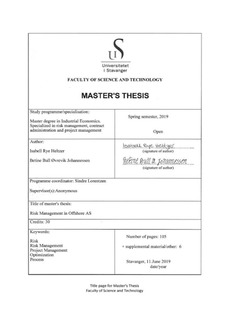| dc.description.abstract | The scientific field of risk management (RM) is not older than 30-40 years, but today it is considered as a critical business function. In a society where large amounts of data are being processed at an ever-faster pace, such as in the oil and gas industry, there is a need for a well-functioning RM system. The system should enable companies to identify and manage risks, as well as support the decision in addressing risk when making decisions under uncertainty.
The purpose of this master thesis is to study how companies in the oil and gas industry manage risk during the whole project life cycle, using Offshore AS as an example. The thesis will investigate if Offshore AS’s process manuals are adhered to and sufficient, and further look into how the risk is transferred between the departments and different stages of a project. In addition, it will also be considered whether it is possible to optimize the RM in Offshore AS. To answer these questions, a review of the company’s internal documents, qualitative case studies of eight previous projects and six semi-structured interviews with key personnel has been carried out.
The document review of the internal process manuals provides an understanding of how Offshore AS manage risk in their organization. The document review is also the basis for the evaluating in the case studies, where previous projects are evaluated against the process manuals. The results from the case studies further provided the foundation for the interview questions, which were intended to verify the findings in the case study.
The evaluation of Offshore AS shows that they satisfy the processes to a large extent, and many of the principles for good RM are implemented. At the same time, the processes are not always adhered to, they are not sufficiently described and there exist signs of errors and weaknesses, which convey that the processes are not optimal and needs improvements. The results indicate that the risk transfer between the various departments is somewhat discontinuous.
In order to improve the risk transfer between the departments, it is important that the processes that have been set are followed and described in more detail, and that they are prioritized independently of available resources. | nb_NO |
